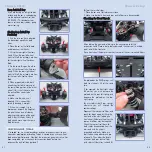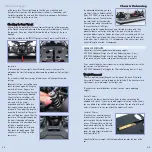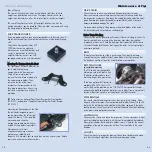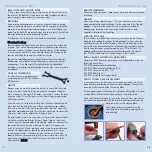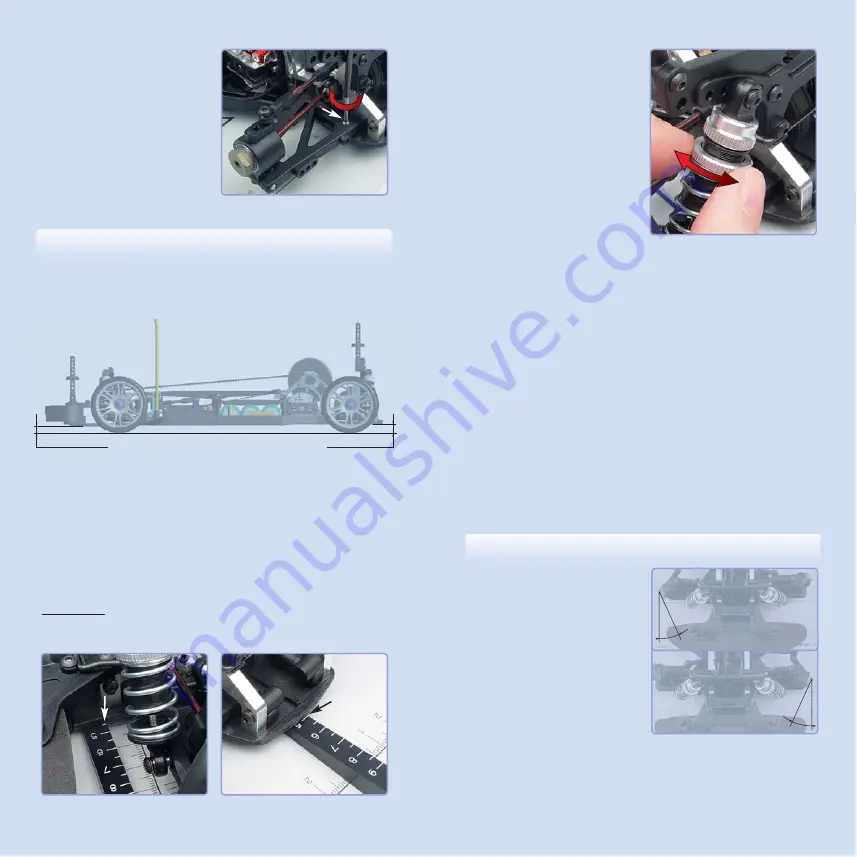
Try using a slightly lower ride height
for high traction conditions, such as
carpet racing.
R
Riid
de
e H
He
eiig
gh
htt a
an
nd
d T
Tiirre
ess
Ride height is measured with the wheels on the car, and the car ready-to-
run. When using rubber tires, your ride height settings should stay
consistent, since rubber tires do not wear down appreciably and reduce
ride height. However, if using foam tires, ride height changes as the foam
tires wear down to smaller diameters. Note that the tires may wear at
different rates front-to-back, and left-to-right, which may eventually result
in a car with uneven ride height at all four corners. When possible, true
your foam tires (left and right pair at a time), and re-adjust your ride height
periodically to compensate for tire wear.
R
Riid
de
e H
He
eiig
gh
htt a
an
nd
d S
Su
ussp
pe
en
nssiio
on
n S
Se
ettttiin
ng
gss
Suspension settings are unaffected by the wheels/tires you put on the car.
When you use a setup system (such as the Hudy Universal Set-Up System
(#10 9300) to set your suspension settings, these settings do not change
when you put different wheels on the car. With the car sitting on the
ground, it may appear that certain settings are different, but this may be
due to uneven tires, or tires with different diameters. However, the settings
you set using a set-up system are the true suspension settings.
ACKERMANN AND STEERING THROW SYMMETRY
Ackermann is a term describing the
effect of the inside front wheel
turning tighter than the outside front
wheel. Ackermann is used to
achieve better steering through the
corners.
When setting up your steering, it is
very important that turning radii are
the same when the car is turning
either left or right. Put the car on a
Hudy Set-Up System to make sure
that the steering turns as sharply to
the left as it does to the right. If it is
not the case and if your transmitter has EPA (End Point Adjustment) settings,
adjust the EPA on your transmitter in order to achieve left/right symmetry.
Downstop settings depend on track
condition. The above setting was for
smaller tires (approx. 63 mm) and a
smooth track.
If you find the car has too much
steering going into a corner off
throttle or while braking, try adding
1mm to the rear downstop setting.
This will cut down on the amount of
weight that is transferred away from
the rear tires when off throttle.
RIDE HEIGHT
Ride height is the height of the chassis in relation to the surface it is sitting
on. Measure and adjust ride height with the car ready-to-run but without
the body. Use the shock preload collars to raise and lower the ride height.
Perform these initial steps:
1. Prepare the car ready-to-run, without body.
2. Place the car on Hudy Set-up Board and use #10 7715 Ride Height
Gauge to measure the ride height in front and rear.
Use the shock preload collars to raise or lower the ride height.
•• TToo rraaiissee tthhee rriiddee hheeiigghhtt::
Tighten the shock preload collars. Collar moves
DOWN the shock body.
•• TToo lloow
weerr tthhee rriiddee hheeiigghhtt::
Loosen the shock preload collars. Collar moves
DOWN the shock body.
Initial Settings:
Front ride height: 4.5mm
Rear ride height: 5.0mm
Chassis Setup
RIDE HEIGHT FRONT
RIDE HEIGHT REAR
20
19
Chassis Setup
STEERING
STEERING
Summary of Contents for T1R Raycer
Page 1: ......

















